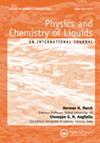拉莫三嗪在丙二醇+ 1-丙醇混合物中的溶解及热力学研究
IF 1.2
4区 化学
Q4 CHEMISTRY, PHYSICAL
引用次数: 0
摘要
摘要采用摇瓶法在293.2 ~ 313.2 K温度下研究了拉莫三嗪(LTG)在丙二醇和1-丙醇非水混合溶剂中的溶解度。采用van 't Hoff、Jouyban-Acree、Jouyban-Acree - van 't Hoff、混合响应面和修正Wilson模型等5种共溶数学模型对实验数据进行了相关性分析,并对模型的可靠性进行了检验。在平均调和温度下,利用范霍夫方程和吉布斯方程计算了LTG在混合物中溶解的表观标准吉布斯能、焓和熵。随着PG加入量的增加,LTG的溶解度增大,在313.2 K时PG质量分数为0.7时溶解度最大。实验结果与上述模型相关,计算数据的平均相对偏差(%)均小于5.0。本研究由大不里士医科大学(Tabriz, Iran)研究部资助,资助号67137。披露声明作者未报告潜在的利益冲突。这项工作得到了大不里士医学科学大学的支持[67137]。本文章由计算机程序翻译,如有差异,请以英文原文为准。
Dissolution and thermodynamic study of lamotrigine in propylene glycol + 1-propanol mixtures
ABSTRACTThe solubility of lamotrigine (LTG) was investigated in non-aqueous mixed solvents of propylene glycol (PG) and 1-propanol by a shake-flask technique in the temperatures of 293.2–313.2 K. The obtained experimental data were correlated by five cosolvency mathematical models include the van’t Hoff, the Jouyban–Acree, the Jouyban–Acree–van’t Hoff, the mixture response surface and the modified Wilson models, and reliability of the models was checked. Furthermore, the apparent standard Gibbs energy, enthalpy and entropy of dissolution of LTG in the studied mixtures were computed using van’t Hoff and Gibbs equations at mean harmonic temperature. The solubility of LTG increases with increasing the amount of PG, and maximum solubility was reached in PG mass fraction of 0.7 at 313.2 K. The experimental results were correlated by the above mentioned models, and mean relative deviations (%) for the computed data were reported to be less than 5.0.KEYWORDS: Solubilitylamotriginecosolvency modelsdissolution thermodynamicsshake-flask AcknowledgmentsThis work was supported by Research Affairs of Tabriz University of Medical Sciences (Tabriz, Iran) under grant number 67137.Disclosure statementNo potential conflict of interest was reported by the author(s).Additional informationFundingThe work was supported by the Tabriz University of Medical Sciences [67137].
求助全文
通过发布文献求助,成功后即可免费获取论文全文。
去求助
来源期刊

Physics and Chemistry of Liquids
化学-物理:凝聚态物理
CiteScore
3.30
自引率
8.30%
发文量
43
审稿时长
6-12 weeks
期刊介绍:
Physics and Chemistry of Liquids publishes experimental and theoretical papers, letters and reviews aimed at furthering the understanding of the liquid state. The coverage embraces the whole spectrum of liquids, from simple monatomic liquids and their mixtures, through charged liquids (e.g. ionic melts, liquid metals and their alloys, ions in aqueous solution, and metal-electrolyte systems) to molecular liquids of all kinds. It also covers quantum fluids and superfluids, such as Fermi and non-Fermi liquids, superconductors, Bose-Einstein condensates, correlated electron or spin assemblies.
By publishing papers on physical aspects of the liquid state as well as those with a mainly chemical focus, Physics and Chemistry of Liquids provides a medium for the publication of interdisciplinary papers on liquids serving its broad international readership of physicists and chemists.
 求助内容:
求助内容: 应助结果提醒方式:
应助结果提醒方式:


